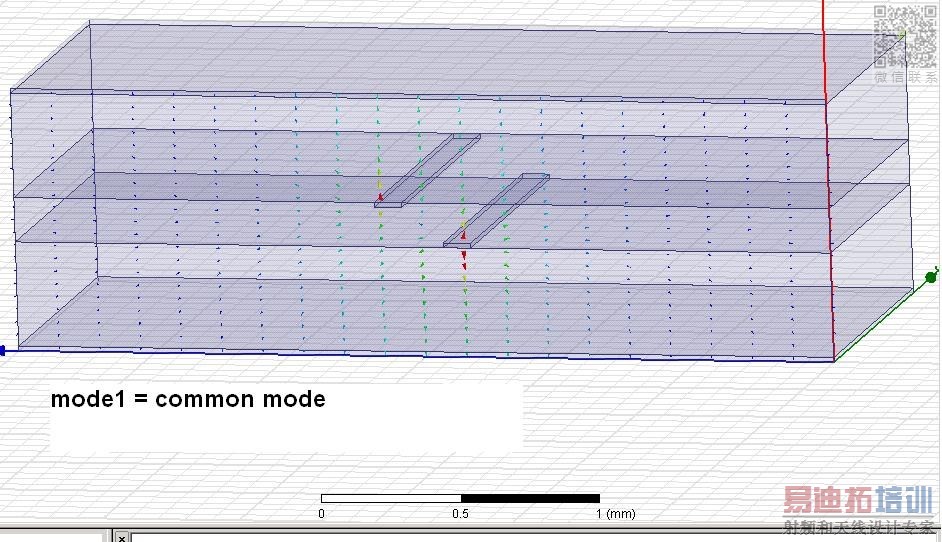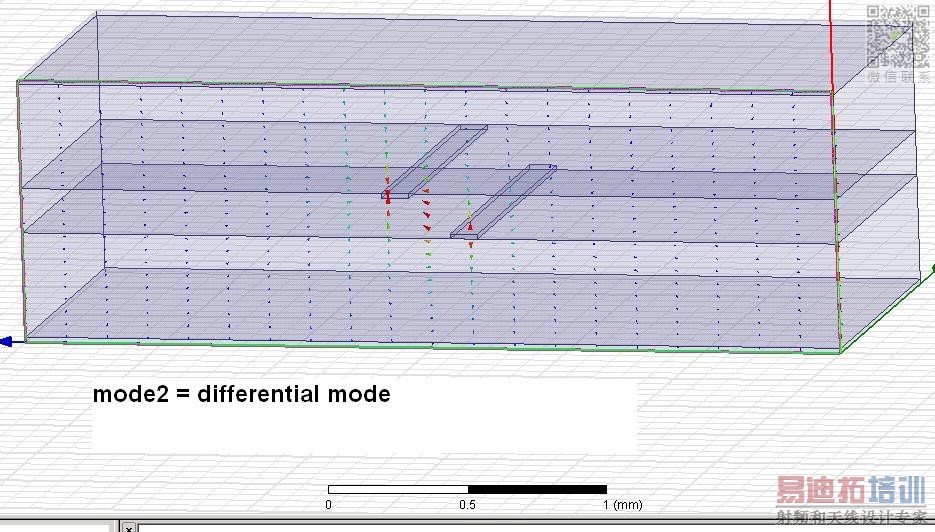- 易迪拓培训,专注于微波、射频、天线设计工程师的培养
2D simulation of broadside coupled stripline
录入:edatop.com 点击:
Hello,
i have strange results when simulating broadside coupled striplines.
It is a 2D EM simulation with Ansoft HFSS. The waveguide port considers two modes.
Impedance calculation is based on the power-current definition Zpi. Simulation freqeuncy is 20 GHz.
The pictures show the simulation setup, the electric field plot of mode1 (common) and mode2 (differential)
and the meaning of the variable dist.
Picture 1.jpg shows the reference impedance Z0=sqrt( Zcommon*Zdifferential) for dist=0mm (strips are not shifted against each other)
and different strip widthes (same width on both strips).
The impedance calculation accuracy is 0.01 percent.
To me, it should be a smooth curve. There should be only one pair of "strip width" and "dist" to acchieve Z0=50 ohm.
Things get even more strange if I simulate for dist values greater zero.
Lets say, we have found the strip width value for dist=0mm to achieve 50ohm.
For a dist value greater 0mm, the even mode impedance should stay rather the same, whereas the odd mode value
increases (capacitance between strips decreases).
To balance this out back to 50ohm, we have to increase the strip width --> Zodd decrease, Zeven decrease --> 50ohm.
But the simulation doesnt show a clear relationship - it is confusing.
Thanks for any comment.
hfss file is attached!
i have strange results when simulating broadside coupled striplines.
It is a 2D EM simulation with Ansoft HFSS. The waveguide port considers two modes.
Impedance calculation is based on the power-current definition Zpi. Simulation freqeuncy is 20 GHz.
The pictures show the simulation setup, the electric field plot of mode1 (common) and mode2 (differential)
and the meaning of the variable dist.
Picture 1.jpg shows the reference impedance Z0=sqrt( Zcommon*Zdifferential) for dist=0mm (strips are not shifted against each other)
and different strip widthes (same width on both strips).
The impedance calculation accuracy is 0.01 percent.
To me, it should be a smooth curve. There should be only one pair of "strip width" and "dist" to acchieve Z0=50 ohm.
Things get even more strange if I simulate for dist values greater zero.
Lets say, we have found the strip width value for dist=0mm to achieve 50ohm.
For a dist value greater 0mm, the even mode impedance should stay rather the same, whereas the odd mode value
increases (capacitance between strips decreases).
To balance this out back to 50ohm, we have to increase the strip width --> Zodd decrease, Zeven decrease --> 50ohm.
But the simulation doesnt show a clear relationship - it is confusing.
Thanks for any comment.




hfss file is attached!
one last try !
申明:网友回复良莠不齐,仅供参考。如需专业帮助,请学习易迪拓培训专家讲授的ADS视频培训课程。
上一篇:ebg ads momentum
下一篇:Problem in dipole antenna design in ADS
ADS培训课程推荐详情>>
 国内最全面、最专业的Agilent ADS培训课程,可以帮助您从零开始,全面系统学习ADS设计应用【More..】
国内最全面、最专业的Agilent ADS培训课程,可以帮助您从零开始,全面系统学习ADS设计应用【More..】
- Agilent ADS教学培训课程套装
- 两周学会ADS2011、ADS2013视频教程
- ADS2012、ADS2013射频电路设计详解
- ADS高低阻抗线微带滤波器设计培训教程
- ADS混频器仿真分析实例视频培训课程
- ADS Momentum电磁仿真设计视频课程
- ADS射频电路与通信系统设计高级培训
- ADS Layout和电磁仿真设计培训视频
- ADS Workspace and Simulators Training Course
- ADS Circuit Simulation Training Course
- ADS Layout and EM Simulation Training Course
- Agilent ADS 内部原版培训教材合集
